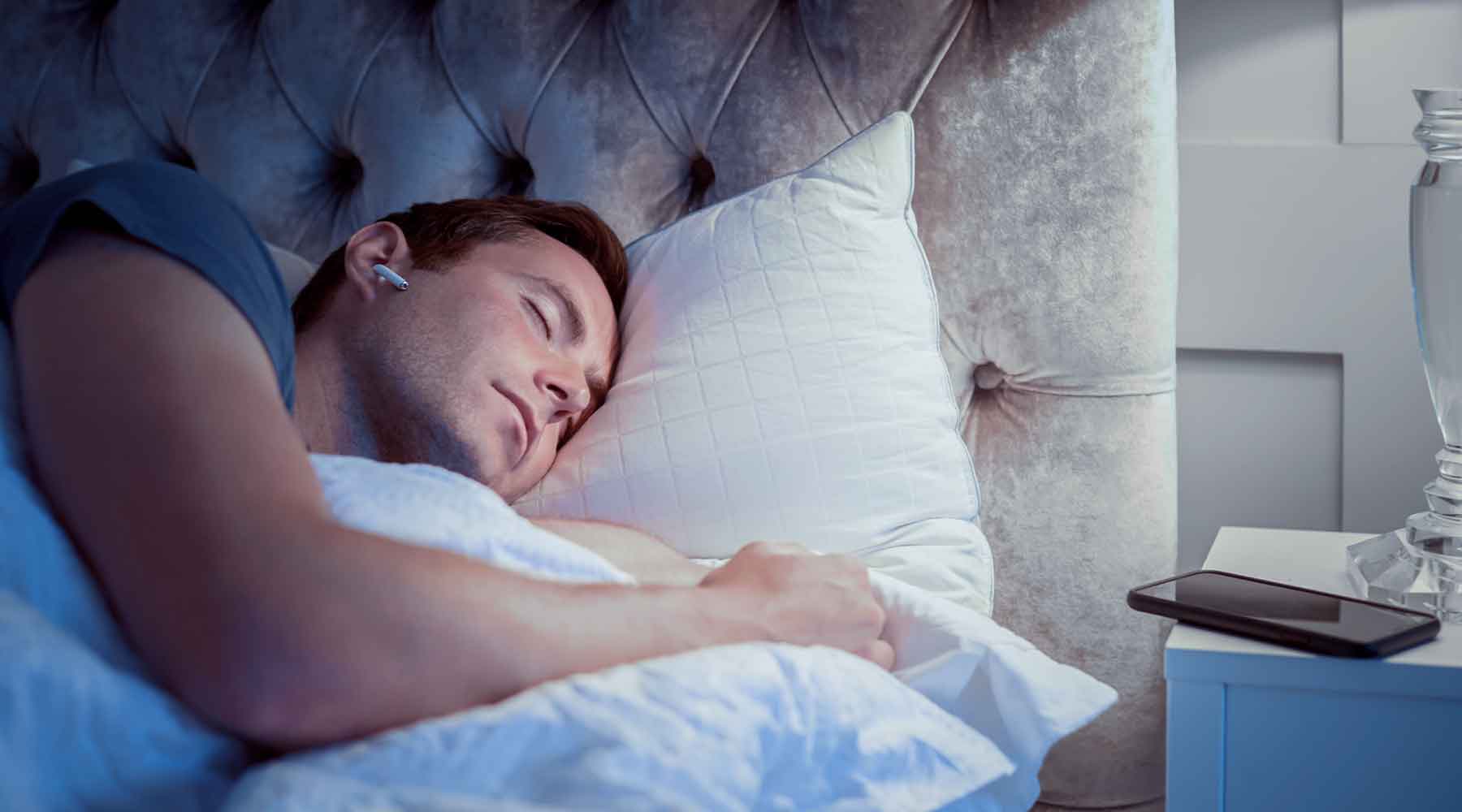
White Noise - Do noises help you fall asleep?
Noise-related difficulty falling asleep and staying asleep are widespread, because our sense of hearing is always active, even while we sleep. Learn more here about how the famous "white noise" affects our body and brain, and whether sounds like white noise, pink noise, and brown noise can improve relaxation and sleep.
Table of contents
- Hearing during sleep
- What is white noise?
- What effect does white noise have?
- How does white noise affect sleep?
- Tips: White noise for better sleep
- White, Pink & Brown – All noise signals at a glance
- Conclusion
Night-active neighbors, barking dogs or the constant snoring of a peacefully sleeping partner – nighttime noise and disturbing ambient sounds are a common reason for nighttime awakening, Sleep disorders and difficulty falling asleep. An increasingly popular way to make it easier to fall asleep and reduce the disturbing effects of nighttime noise is to listen to so-called white noise. – in English: white noise. How can or should this work?
1. Hearing during sleep
Our ears never sleep! At night, not only the brain is working at full speed, but also many of our Senses remain activeOur sensitive hearing, in particular, constantly reacts to acoustic stimuli from our environment during sleep and while falling asleep. Persistent noise, sudden sounds, or other strong acoustic signals trigger activation of the nervous system, even at night, and can thus impede restful and undisturbed sleep.
The key factor here is how a noise is ultimately processed and evaluated in the brain. The brain is certainly capable of filtering out certain sounds from a sound environment and blocking out less important signals. However, especially when a noise stands out from an otherwise quiet environment, the brain is quickly put on alert, which can hinder the process of falling asleep or cause us to wake up.

The human ear covers a frequency range of approximately 20 to 20,000 Hertz. Depending on the sleep phase Depending on where we are, our hearing sensitivity can vary. During deep sleep, we don't even really perceive many sounds, as our body is focused on regeneration and recovery. During REM sleep, however, our sense of hearing is more sensitive, because during this time our brain is already very active and reacts faster and more strongly to acoustic stimuli in our environment. To fall asleep easily and sleep through the night undisturbed, a generally quiet sleeping environment is recommended.
2. What is white noise?
White noise can be described as a monotonous, artificially generated sound consisting of a combination of tones of all frequencies perceptible to humans, all at equal intensity. This means that many different sounds are layered on top of each other, creating a dense, indefinable noise that sounds something like a rushing waterfall or when the radio or television is tuned to a station.

3. What effect does white noise have?
Although the constant white noise is constantly perceived by the ear, the brain generally rates it as being of little relevance and most people no longer consciously perceive it after a short time.Through the steady, but not overly demanding, impulses to the ear, our brain gradually relaxes and simply tunes out the monotonous noise, lowering our hearing threshold for other (disturbing) sounds. White noise creates an overall "loud" sound environment, in which sudden noises stand out less. This makes us less sensitive to those sounds we perceive as negative and allows our brain to calm down more easily.
4. How does white noise affect sleep?
Numerous scientific studies show that white noise can lead to more peace and relaxation and is effective against Stress symptoms such as headaches or inner restlessness. This not only improves our resistance to stress and our ability to concentrate during the day, but also improves the conditions for restful sleep.
Especially during the process of falling asleep and throughout the rest of the night, white noise can help neutralize disturbing noises from the sleeping environment and prevent sleep interruptions caused by sudden sounds. This way, we can protect our brain from stress, promote a peaceful fall asleep, and also support sleeping through the night.
5. White Noise, Pink Noise, Brown Noise – Noise Signals at a Glance
Whether we actually find these monotonous sounds pleasant and helpful varies from person to person. White noise is a very popular sleep aid because it has a consistent and dense overall sound. However, there are other noise signals that have a similarly positive effect on our body, brain, and nervous system, helping us sleep better. They differ primarily in the frequency spectrum used.
White Noise
White noise comprises sounds of all frequencies from a frequency range of approximately 20 to 20,000 hertz, layered at the same volume. The result is an indefinable noise of high, mid, and low tones that can be compared to the sound of heavy rain, waterfalls, a humming machine, or the familiar "TV interference."
Pink Noise
Pink noise is very similar to white noise, differing only in that the high frequencies are used more quietly than the low ones. Pink noise sounds somewhat deeper and less intense than white noise, which some people find more pleasant and calming.
A comparable sound is the sound of pattering rain. With the window open, it sounds similar to white noise; with the window closed, it's more like pink noise.
Brown Noise/Red Noise
Brown or red noise sounds even deeper overall than pink or white noise and is created by further reducing the volume of sounds in the high and mid-frequency range. This comparatively deeper and darker-sounding noise is often compared to the sound of calm ocean surf or a thunderstorm.
6. Tips: White noise to improve sleep

You can especially benefit from the proven positive effects of noise signals in the evening or while falling asleep. You can find special sleep sounds on YouTube, Spotify, and in our
By the way: Find out whether music can also have a positive effect on falling asleep here.
#1 Speakers vs.headphones
If you want to listen to music, a podcast, or any of the noise signals to fall asleep, it is of course recommended to use a speaker instead of headphones to prevent unpleasant pressure on the ears or tangled headphone cables during the night.
#2 Sleep Use timer
Use a
#3 Adjust the volume correctly
The volume level at which white, pink, or brown noise sounds comfortable to you depends on your individual needs. Make sure it's set neither too loud nor too quiet. Too loud noise can still be perceived as disruptive during sleep, whereas too low a volume can lead to us no longer being able to perceive the white noise at all, and the positive effects are lost.
7. Conclusion
-
Our hearing is also very active during sleep, which is why nighttime noise is a common cause of problems falling asleep and staying asleep
-
White noise is a monotonous sound that can calm the body, brain and nervous system and mask disturbing noise
-
White noise has been proven to help reduce stress, make it easier to fall asleep, and promote sleep through the night
-
In addition to white noise, pink noise and brown noise also have a positive effect on stress, relaxation and sleep
Best wishes and see you soon!




Leave a comment
This site is protected by hCaptcha and the hCaptcha Privacy Policy and Terms of Service apply.